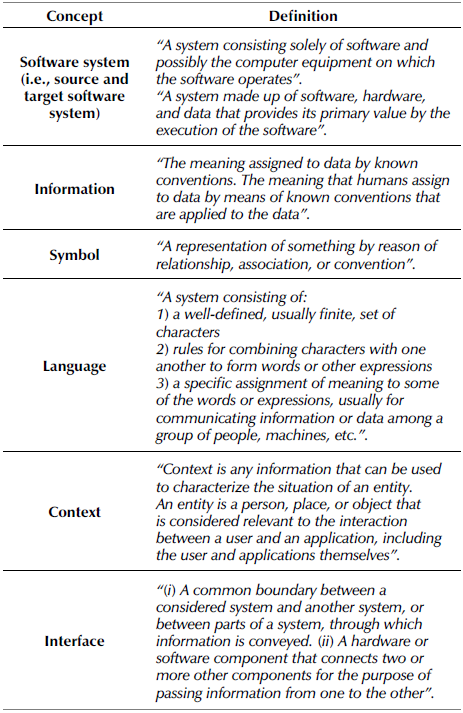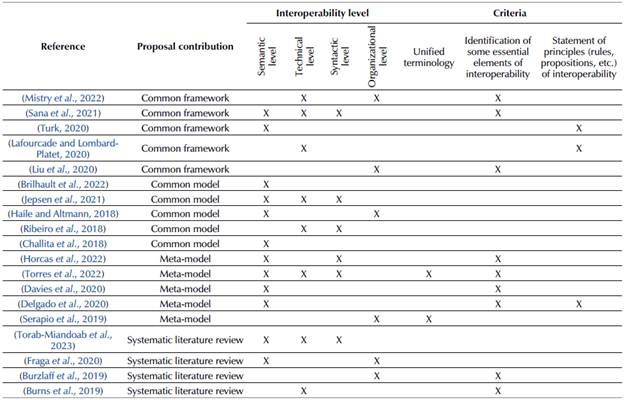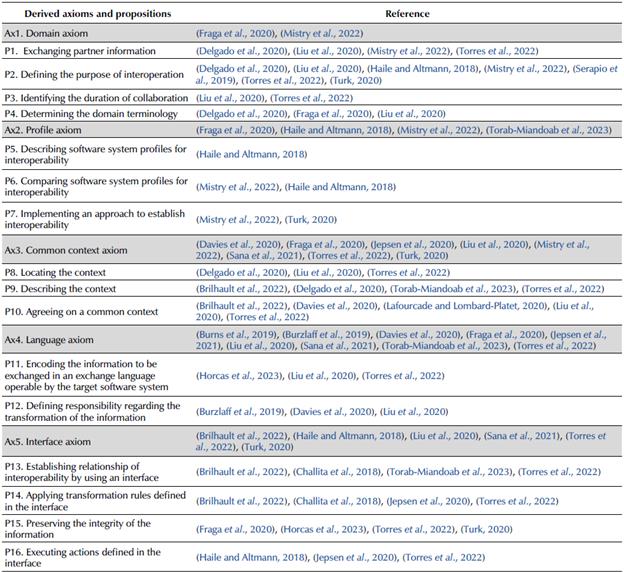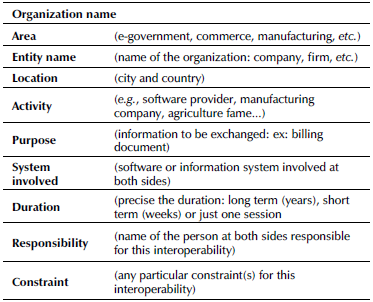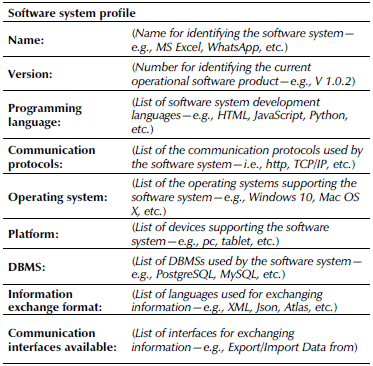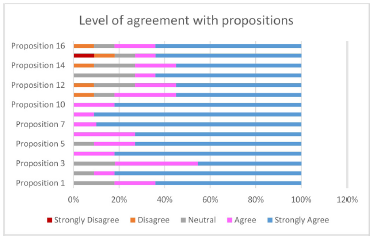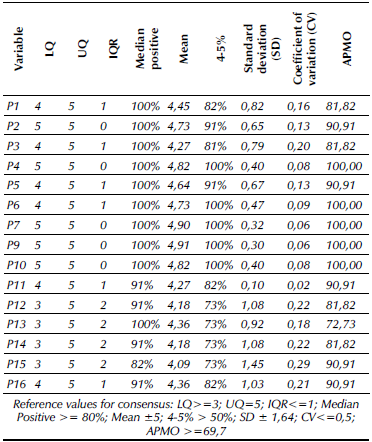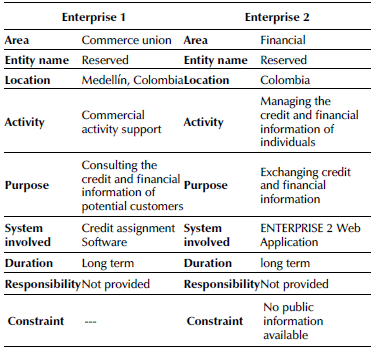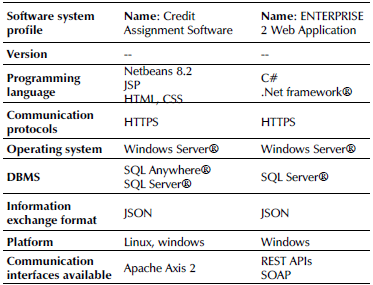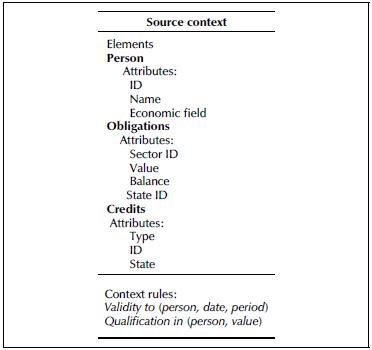Introduction
Interoperability is referred to as a software quality property (International Organization for Standardization, 2008), an ability of entities for working together (Liu et al., 2020), and a feature of information systems (Turk et al., 2020), among other definitions. A characteristic of interoperability is the possibility of using exchanged information, i.e., understanding and interpreting the exchanged information without additional effort.
Seven essential elements have been identified and defined for describing interoperability (Torres et al., 2018): software system (source and target), information, language, symbol, context, and interface (Table 1). Uniformity in the terminology of interoperability is a requisite for building a common theory.
A software phenomenon like interoperability can be explained by using a theory. The elements of a theory are constructs (called essential elements) and the relationships between them. Building a theory comprises five steps: (i) defining essential elements, (ii) defining propositions, (iii) providing explanations about the propositions, (iv) determining the scope, and (v) testing the theory (Sjøberg et al., 2012). A theory can also be conceived as axiomatic when it introduces new concepts and deduces their properties (Tall, 2004).
Theoretical contributions regarding interoperability (Table 2) attempt to formalize, characterize, and describe it according to different perspectives. To this effect, they use common frameworks defining concepts, practices, and criteria related to interoperability; common models representing interoperability solutions; meta-models including models of problems involving interoperability; and, finally, systematic literature reviews useful for collecting proposals focused on the challenges of interoperability.
The aforementioned contributions have at least one of the following problems:
The authors refer to interoperability by using a disunified terminology. The causes are a lack of consensus about what interoperability is, the lack of a unified vocabulary, and an incomplete characterization of interoperability.
The essential elements describing interoperability are not explicitly identified. The causes include the following: a complete view of interoperability is missing; comparing the approaches to interoperability is difficult; and some interoperability solutions which use current approaches are missing.
Interoperability principles are left aside because interoperability problems are difficult to identify and the source of the problems is disregarded.
A general view of interoperability is not reached because the proposals are focused on a single level of interoperability, i.e., technical, syntactical, semantic, or organizational. A general and complete representation of interoperability is still missing.
This paper presents an axiomatic theory of interoperability based on a set of axioms and propositions. Such an axiomatic theory involves the seven essential elements of this concept. Axioms and propositions are stated in order to explain the role of each essential element during interoperability, as well as the relationships between such elements. Moreover, a discussion about the stated propositions is carried out which involves a group of independent interoperability experts.
An illustrative example is proposed with the aim to demonstrate the applicability of the axioms and propositions in a real situation. The example is taken from a local software development company.
The proposed axiomatic theory seeks to explain the interoperability that occurs between two software systems when information is transmitted by using an interface. Such information (containing symbols) is written in a language and interpreted according to a common context. Additionally, the axiomatic theory is used for describing how the essential elements are related, characterizing related problems based on the essential elements and the rules of interoperability, as well as comparing approaches by using a unified characterization.
Theoretical contributions analysis
To gather theoretical contributions regarding interoperability, a systematic literature review methodology was applied (Software Engineering Group, 2007). This method involved the following phases:
1. Planning
The main research question is What is the set of essential elements for describing interoperability? Information sources include scientific papers from 2000 to 2022 in databases such as Science Direct, IEEE Xplore, Springer, Scopus, and Google Scholar. The query was defined as follows: (Interoperability OR Interoperate OR Interoperation OR Interoperable) AND (Systems OR Software OR "Software systems") AND (Theory OR Formal OR Axiomatic OR Formalization OR Theoretical OR General).
2) Execution
The search was performed once in 2022 and again in 2023 for recent studies. The following selection criteria were applied after reading the abstracts and keywords: a) papers written in English from peer-reviewed conference proceedings, journal articles, book sections, and doctoral dissertations; b) papers with title and keywords related to formaliza-tions regarding the concept, with interoperability as a main topic, and empirical studies; and c) articles including formalizations and models of interoperability in different kinds of software systems.
3) Results and analysis
106 (93 + 13) studies were collected for analysis. Three kinds of study were identified: general models, meta-models, and models of interoperability. Given our interest in generality, 38 papers presenting general models and meta-models were analyzed. Table 2 reports the 19 most recent papers (20182023).
As a result, it was noted that theoretical contributions regarding interoperability embrace approaches proposing common frameworks, common models, meta-models, and systematic literature reviews.
Common frameworks
Standards are used for reaching a common terminology about some aspects of interoperability. However, such terminology is specific to some issues regarding the concept (e.g., interoperating heterogeneous manufacturing software units) and disunified concerning other proposals.
In other interoperability frameworks, an analysis of some interoperability levels (technical, syntactic, semantic, and organizational) is performed. Interoperability is evaluated within a specific context (e.g., cloud, construction, enterprise, etc.). Therefore, a general view of this phenomenon has not been reached. Some proposals discuss the necessary information and conditions for accomplishing systems interoperability. However, such proposals are based on a disunified terminology, and their scope is limited to a given context.
Common models
Some common models aim to implement solutions to specific interoperability problems. Thus, an abstraction of this phenomenon is difficult, and some elements are overlooked. However, the formalizations of interoperability presented in said models are useful for identifying relationships and patterns of interoperability.
Meta-models
It is possible to identify two types of interoperability metamodels: (i) meta-models focused on data representations by using formalisms (e.g., categorical theory, semantic models, and mathematical foundation, among others) which have partial views of interoperability; for this reason, they are limited for addressing some interoperability problems; (ii) meta-models with a high level of abstraction about interoperability and specific perspectives of the systems (e.g., business processes, software systems, and general systems theory), which are limited by their areas of interest. In both types of meta-models, the principles of interoperability are left aside, and a disunified terminology is addressed.
Systematic literature reviews
There are reviews of current research on interoperability and its future needs. These works are useful for understanding the need to formalize interoperability and for analyzing how some elements of interoperability are used in the descriptions of this concept.
The findings related to the gaps in the previous works are summarized in Table 2.
Methodology
This section proposes an axiomatic theory for explaining what interoperability is and how to achieve it. In this theory, axioms seek to thoroughly describe what interoperability is, while propositions are statements about what is needed for achieving interoperability (Figure 1). Such an axiomatic theory is based on the identified essential elements of interoperability, i.e., source software system, target software system, information, context, language, symbol, interface, and their relationships.
In addition, it is necessary to understand how the seven essential elements relate to each other, what role they play in establishing interoperability (exhibited relationship), and what dependencies and attributes they have. To this effect, the literature was examined by using an adapted methodology comprising three stages: structural and functional analysis, semantic processing, and discourse mapping. As a result, a pre-conceptual schema (PCS) of the essential elements and their structural relationship was obtained (Torres et al., 2022).
The relationships observed between the essential elements indicate that interoperability happens at least between two software systems: a source and a target software system. By instantiating the PC of interoperability (Torres et al., 2022), it is possible to realize that, even though a two-way relationship is expected (e.g., an answer derived from the exchange), our model allows representing such a situation while changing the roles of the software systems involved. The core element of interoperability is information, which is created by the source software system and used in the target software system. The information is written by using some language and exchanged via an interface. Symbols are part of its content. Each software system has its own context, which describes a set of software system elements used for matching and transforming the exchanged information. Furthermore, a common context is necessary for interpreting the information.
With the results of the mapping and unification process and the interoperability PC about the relationships between essential elements, a new perspective was established, aimed at reaching underlying and intuitive reasoning regarding how the essential elements should be arranged for achieving interoperability. All this, while considering the definitions of axioms as well accepted statements and the propositions as facts accepted by the expert community (Tall, 2004). This work focused on recognizing and analyzing such statements (i.e., well accepted statements and facts) with regard to each essential element (including its mapped concepts), looking at statements like:
"Interoperability is characterized" AND "interoperability means" AND "interoperability requirements are" AND "the means to achieve interoperability" AND "interoperability is provided by means" AND "to ensure interoperability is necessary" AND "an interoperable system meets" AND "to establish interoperability" AND "interoperability depends/ requires".
As a result, an axiomatic theory of interoperability can be proposed which is supported by the findings of the literature (Figure 2).
Axiomatic theory of interoperability
AXIOM 1. INTEROPERABILITY DOMAIN - Exchanging domain information to prepare interoperability.
When one needs to establish interoperability between the software systems of two organizations, the domain information of both software systems should first be exchanged for a preliminary mutual understanding of their backgrounds.
For example, if one needs to establish interoperability between two software systems in different domains such as e-Government (encompassing entities as citizens, business, administration, etc.) and e-health (encompassing entities as citizens, administration, e-surveillance, etc.), this mutual understanding (respect towards partner information, the purpose and duration of interoperability, and the domain terminology) is very important as a starting point.
Proposition 1: Exchanging partner information
Partners should exchange information to allow their collaboration. This includes organization names, location, economic sector, people in charge of a possible collaboration, and any potential constraints.
Proposition 2: Defining the purpose of interoperation
It is important to identify the purpose and what will be exchanged between the two software systems in order to be prepared for establishing interoperability.
Proposition 3: Identifying the duration of collaboration
The duration of the collaboration between two software systems must be defined, as well as the frequency of interoperations.
Proposition 4: Determining the domain terminology
In order to establish semantic interoperability between two software systems in different domains, it is important to identify the differences between their terminologies. This can be done by using an ontology, a glossary, software documentation, etc.
Figure 3 presents a template to provide domain information for interoperability purposes.
AXIOM 2. INTEROPERABILITY PROFILE - Exchanging software profile for interoperability
When two software systems seek to interoperate, they should exchange information about their software profiles in order to predict the possibility of interoperation.
Proposition 5: Describing software system profiles for interoperability
Software profiles for interoperability must be first identified and described. These are sets of characteristics describing some particular aspects of a software system relevant for interoperability, such as the coding language, the operating system, the protocol for communication, etc.
A template for documenting such characteristics is proposed in Figure 4.
Proposition 6: Comparing software system profiles for interoperability
Exchanging and comparing profiles of two software systems allows knowing whether they are interoperable (according to the differences between their profiles) and consequently searching for an appropriate solution to establish interoperability.
Proposition 7: Implementing an approach to establish interoperability
Incompatibility between two software system profiles leads to failures of interoperability. Therefore, an appropriate approach (i.e., integrated, unified, and federated) (International Organization for Standardization, 2011) should be implemented to establish interoperability.
An integrated approach means using a common format and language in each system. A unified approach implies building a neutral format at the meta level for mapping two systems. A federated approach involves dynamically negotiating and mapping two systems 'on the fly' (i.e., without a pre-defined format/language). The choice depends on the context and the requirements of interoperability.
AXIOM 3. INTEROPERABILITY CONTEXT - Interpreting exchanged information using a common context
Exchanged information can be correctly understood when both software systems have a common context.
Proposition 8: Locating the context
Before interoperating, both software systems should define and agree on the minimum level of detail regarding each context necessary to understand the information they are going to exchange.
Proposition 9: Describing the context
A prerequisite for establishing interoperability is to describe the context of each software system as a list of software system elements, their attributes, and their rules.
Proposition 10: Agreeing on a common context
Agreeing on a common context consists of identifying relationships between the elements of the source and the target software systems.
A common context should include the relationships stating the direct matching of the elements in both contexts, the necessary rules for transforming source elements into target elements, and rules describing how to interpret particular elements of the source software system.
Without a common context between source and target software systems, the understanding and use of information is uncertain, and it could be misinterpreted. Such lack of agreement on the exchanged information can generate conflicts in the target software system, i.e., business rules violations, loss of consistency in the information, and lack of reliability with regard to the information.
AXIOM 4. INTEROPERABILITY LANGUAGE - Encoding information for interoperability
An exchange language is used for encoding information to be sent to another software system. The exchange language should be recognized by the two software systems that are going to interoperate.
Proposition 11: Encoding the information to be exchanged in an exchange language operable by the target software system
Information is written in the source software system by using an exchange language recognized by the target software system. The source software system has one or several exchange languages used for transmitting information.
Proposition 12: Defining responsibility regarding the transformation of the information
During the interoperation between two heterogeneous software systems, the exchanged information should be transformed into a language/format understandable by the target software system. The responsibility of this transformation should be defined before interoperation, and it may be assigned to the source or to the target software system.
AXIOM 5. INTEROPERABILITY INTERFACE- Establishing interface for interoperability
An interface is needed for establishing a relationship between the source and the target software systems during interoperation. A relationship between said systems implies linking their elements. When an interface is used, a clear identification of the actions to be executed in the transmission of information is required.
Proposition 13: Establishing relationship of interoperability by using an interface
An interface is an established agreement between two software systems. This agreement includes specifications, e.g., what language will be used during the exchange, what languages/translators are available for understanding the information, what are the contexts of both software systems, how the common context for the two software systems should be established, what transformation rules are necessary, what conditions are imposed in the elements of each context, and what actions are needed to perform the exchange.
Proposition 14: Applying transformation rules defined in the interface
Transformation rules are descriptions about the way in which source software system elements are related to target software system elements. Transformations rules seek to describe, in a formal language, the following equivalences: (i) element to element, when an element of source software system is a representation of the same entity in the contexts of the two systems; (ii) attribute to attribute, when attributes of elements representing the same entity or different entities refer to the same property; and (iii) element to attribute, when an attribute is represented as an element in the other context.
Proposition 15: Preserving the integrity of the information
Conditions in the source software context are constraints regarding the way in which the elements interact within the software system. Conditions are conveyed by using an interface to preserve the integrity of the information. A decision about the need to respect the conditions should be made in the target software system.
Proposition 16: Executing actions defined in the interface
The interface contains actions seeking to establish interoperability between the source and the target software systems. These actions include (a) establishing communication with the target software system; (b) agreeing on the common context of both software systems; (c) transforming information from a language (chosen by the source software system) to a language recognized by the target software system; and (d) conveying the information to the target software system.
In addition, adequate data must be used for performing these actions (required data), and the results must be delivered as a dataset (provided data).
Results
Eleven experts were invited to review the proposed axiomatic theory and answer a previously approved questionnaire. The participants met the following criteria: experience in software interoperability (i.e., university professors, researchers, consultants, and professionals), work related to interoperability (i.e., interoperability research, software quality, interoperability projects for industry, and formal methods for software engineering), years of experience (two or more), and academic degree (i.e., Master and PhD). The results regarding the level of agreement on a five-point Likert scale (strongly agree, agree, neutral, disagree, and strongly disagree) are presented in Figure 5. Table 3 also summarizes the results concerning some indices used for declaring consensus.
Consensus with all propositions can be declared because there are positive results in at least three of the evaluated indices (Table 2). Nevertheless, the concerns of the experts with propositions 12-15 can be discussed based on the results in the interquartile range (IQR) measure. The expert concerns on proposition 12 are related to the transformation of the information. The experts considered that such a responsibility should be addressed in the interface or in a third system. However, we believe that such a decision should be assigned within an explicit or implicit negotiation between the two systems.
Regarding propositions 13 and 14, some experts referred to the need for a means to exchange information (corresponding to the proposed definition of interface) in the form of APIs, database links, cloud servers, web servers, etc. The conception of an interface as a pre-established agreement was also the main concern of other experts. Such an agreement can be unilateral, as in the case of the aforementioned mechanisms (an analysis from a practical point of view could be necessary). In addition, some experts hesitated on the need for transformation rules, as systems sometimes have equivalent profiles and contexts, and interoperability can be directly established.
As for proposition 15, the expert concerns mainly revolve around the time when the preservation of the information should happen (before or after transformation).
Regarding propositions 13 and 14, some experts referred to the need for a means to exchange information (corresponding to the proposed definition of interface) in the form of APIs, database links, cloud servers, web servers, etc. The conception of an interface as a pre-established agreement was also the main concern of other experts. Such an agreement can be unilateral, as in the case of the aforementioned mechanisms (an analysis from a practical point of view could be necessary). In addition, some experts hesitated on the need for transformation rules, as systems sometimes have equivalent profiles and contexts, and interoperability can be directly established.
As for proposition 15, the expert concerns mainly revolve around the time when the preservation of the information should happen (before or after transformation).
Illustrative example
To provide an example, the case of a software development company dedicated to supporting the needs related to the technology and processes of SMEs was considered. This company seeks to develop software based on Microsoft technologies (i.e., Web, desktop, and mobile applications and service-oriented software). Their main customers are in the judicial, real estate, and CRM sectors.
Specifically, the example corresponds to the software systems of two companies in the commerce and financial sectors. The purpose of interoperability has to do with the target software system's need (the commerce company) for obtaining customer financial information. The source software system (the financial company) only provides such information to authorized partners. The target software system should commit to respecting the regulatory policies regarding information management, as well as the rules pertaining to the permanence of the information, among others.
AXIOM 1. INTEROPERABILITY DOMAIN
According to propositions 1 and 2, the preliminary information of the two organizations is summarized in Figure 6. Based on proposition 3, the duration of the collaboration is limited to the duration of the agreement between the two organizations. The frequency of interoperability is expected to be at least once a day. Additionally, the necessary domain terminology is provided in the form of a regulation document, as well as the API documentation of the source software system, according to proposition 4. This terminology is related to terms such as information holder, information source, and information operator, among others.
AXIOM 2. INTEROPERABILITY PROFILE
According to proposition 5, the interoperability profile is filled with the available information, which is shown in Figure 7. However, the main requirements for interoperability are determined in a unilateral agreement using a web service provided by the source software system. Hence, it is not necessary to exchange some information.
According to proposition 6, the software system profiles allow identifying a popular standard description for applications intended to consume and deploy web services. This kind of standardization facilitates communication between heterogeneous software systems. Based on the two software system profiles, interoperability between them might be possible. The method employed is more similar to the unified approach, according to proposition 7, as there is a neutral format known by both software systems, albeit not jointly agreed.
AXIOM 3. INTEROPERABILITY CONTEXT
According to proposition 8, the necessary details of the context for interoperating both software systems is conditioned by the web service provided, i.e., the source software system only delivers the pre-determined information about the customers, as requested by the target software system, and it should be inferred according to the format of the exchanged JSON file. The source software context (Figure 8) is hidden from the target software system. According to proposition 10, the common context is defined on the target side during the integration of the exchanged information (i.e., for creating and updating information of the customers).
AXIOM 4. INTEROPERABILITY LANGUAGE
According to proposition 11, the exchange language is JSON, which is recognized by both software systems. The source software system is programmed for exchanging a JSON file. The standard structure of this language is commonly recognized and involves context. Transforming the exchanged information is the responsibility of the target software system, according to proposition 12. This responsibility is implicitly defined in the interoperability agreement.
AXIOM 5. INTEROPERABILITY INTERFACE
According to proposition 13, the two organizations have agreed to establish an interface via the web service provided by the source software system. This system seeks to produce an identity certificate and a public key that provides access to partner companies. Settings should be accepted by the target software system in order to achieve communication, exchange, common understanding, and accessibility to the information, according to proposition 16. As stated in proposition 14, the transformations are applied according to the JSON structure, which maps the information in objects of the target software system's model.
According to proposition 15, the target software system should respect the conditions contained in the source software system's documentation, given that financial information is sensitive to the precise moment in which the exchange happens, as well as to the interpretation given by the source software system. For example, the expiration period of the report is only seven days. In addition, a positive rating for a company or individual means that all obligations are up to date.
Discussion
The proposed explanation of what software interoperability is and how it works leads to recognizing the interaction between its seven essential elements. The lack of a unified terminology leads to different definitions of interoperability, depending on the approaches and type of interoperability addressed. A definition using the seven essential elements allows characterizing issues with a complete view of all the elements and actors involved. Moreover, a common characterization is useful to compare, discuss, and evaluate different approaches of interoperability.
The above-presented axioms are descriptions of what is needed for achieving interoperability. These descriptions can constitute a roadmap for addressing an interoperability project between organizations. This, with regard to (i) determining the necessities of interoperability (i.e., intention, purpose, duration, and frequency); (ii) collecting information about software systems' interoperability features and profiles as a feasibility study; and (iii) implementing an approach to establish interoperability. The propositions are a reference for understanding the necessary arrangements made between software systems, which should be solved in order to achieve interoperability. The proposed axiomatic theory seeks to analyze and discuss approaches of interoperability and is useful for identifying issues in this regard, as well as their causes.
Conclusions and perspectives
This paper proposes an axiomatic theory (five axioms and sixteen propositions) of interoperability between heterogeneous software systems. This axiomatic theory is based on the seven essential elements of interoperability (and their relationships). An interoperability domain template and software system profiles are also proposed. Additionally, the notions of context and language, regarded as essential elements but lacking in the state of the art, are developed in their corresponding axioms and propositions.
As a result of this research, the proposed axiomatic theory allows explaining how interoperability happens and how it can be achieved. Consultation with some experts allowed validating the pertinence and consistency of the proposal. Finally, the application of the theory in a case study regarding a software development company showed the relevance and feasibility of the approach.
By using this example, it was determined that the relationships between essential elements are appropriately stated for identifying and describing interoperability issues and their solutions. Thus, the compliance of the propositions and the completeness and expressiveness of the axiomatic theory can be verified.
To conclude, the axiomatic theory presented herein allows (i) understanding what interoperability is and how it can be established, (ii) describing interoperability issues, and (iii) recognizing the source of said issues and addressing their solutions.
As future work, our axiomatic theory could be used for characterizing open issues of interoperability and identifying practices and activities intended to achieve it. Moreover, using this theory for creating measures and measurement methods of interoperability can provide the state of the art with added value. Finally, the axiomatic theory could be applied for collecting data and creating methods in different stages of software system development, such as planning, analysis, implementation, deployment, and maintenance, seeking to predict, detect, and solve interoperability issues. All this, with the aim to advance the maturity of software system interoperability.














